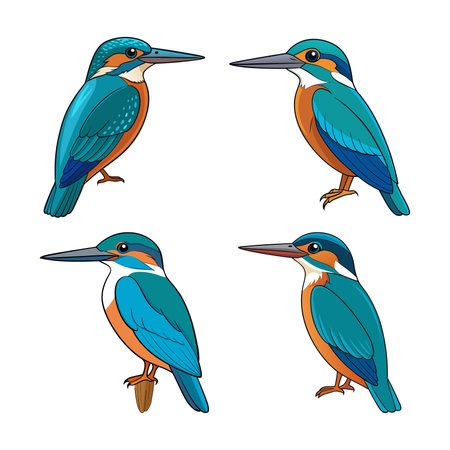1. Introduction to Birdwatching in the UK
Birdwatching is a much-loved pastime across the UK, offering families a wonderful way to connect with nature and each other. With its rolling countryside, vibrant woodlands, and picturesque wetlands, Britain is home to a rich tapestry of birdlife throughout the seasons. Whether you’re exploring your local park or venturing into one of the UK’s treasured nature reserves, birdwatching provides an accessible and rewarding experience for all ages.
For families, birdwatching walks are more than just a chance to spot a robin or a heron—they’re an opportunity to slow down together, spark curiosity in young minds, and foster a lifelong appreciation for the natural world. Children can delight in ticking off birds from their spotter’s lists, while parents enjoy peaceful moments surrounded by British wildlife. These shared outdoor adventures encourage teamwork, patience, and observation skills—all within the fresh air of our beautiful landscapes.
What sets birdwatching apart in the UK is its unique blend of tradition and accessibility. From grand estates in the countryside to urban green spaces teeming with life, there’s a birdwatching walk suitable for every family—no specialist gear required. With friendly communities and plenty of resources available, it’s easy for beginners to get started. So pack your wellies and binoculars, gather your loved ones, and set out on a journey to discover the feathered wonders that make British nature so special.
Essential Tips for Family Birdwatching
Birdwatching as a family in the UK can be a delightful and educational way to explore the great outdoors together. If you’re just starting out, it’s helpful to know how to prepare for your adventure and keep everyone involved, especially with our famously unpredictable British weather. Here are some practical tips and suggestions to help your family make the most of your birdwatching walks.
Family-Friendly Birdwatching Kit Essentials
| Item | Why It’s Useful | UK-Specific Advice |
|---|---|---|
| Binoculars (child-sized options available) | Makes spotting birds easier and more exciting for all ages | Look for lightweight models suitable for little hands; waterproof options are ideal for rainy days |
| Pocket Field Guide or Bird ID App | Helps identify common UK birds and keeps kids curious | Choose guides featuring British species, or try apps like Merlin Bird ID (with UK coverage) |
| Notebooks & Pencils | Encourages children to record their sightings and draw what they see | Rain-resistant notebooks are perfect for damp conditions |
| Weatherproof Clothing & Sturdy Footwear | Keeps everyone comfortable, dry, and happy on all terrains | Packing wellies and a light waterproof is always wise in the UK! |
| Packed Snacks & Drinks | Avoids mid-walk grumbles and keeps energy up | Thermos flasks for hot chocolate go down a treat during chilly months |
| Sunscreen & Hats (even on cloudy days) | Protects skin from unexpected sun exposure during long walks | The British sun can be deceiving—always come prepared! |
Keeping Children Engaged on Walks
- Create a Bird Bingo Game: Make a simple bingo card of common local birds; see who spots the most!
- Bring a Magnifying Glass: Encourage curiosity by letting children examine feathers, leaves, or insects along the trail.
- Take Turns as ‘Chief Spotter’: Give each child a chance to lead the group and point out interesting finds.
- Tell Stories: Share tales about different birds you might see—robins at Christmas or swans in British folklore can spark imaginations.
- Praise Curiosity: Celebrate every sighting, no matter how common. Each discovery helps nurture a love for nature.
Staying Safe and Comfortable in British Weather
- Check Local Forecasts Before You Go: The Met Office app is handy for up-to-date information.
- Dress in Layers: The weather can change quickly; layers help everyone stay warm or cool as needed.
- Avoid Slippery Paths After Rain: Stick to well-maintained routes in country parks or RSPB reserves if it’s been wet recently.
- Stay Together: Remind younger children not to wander off. Set regular meeting points if walking in larger groups.
- Carry a Simple First Aid Kit: Plasters for scrapes and wipes for muddy hands are always useful!
A Little Preparation Goes a Long Way!
A successful family birdwatching walk is all about comfort, curiosity, and safety. By planning ahead with the right kit, keeping activities fun, and dressing appropriately for whatever the British skies bring, you’ll create wonderful memories together exploring nature across the UK’s beautiful landscapes.

3. Top Family-Friendly Birdwatching Locations
If you’re planning a day out with the family, the UK is full of fantastic spots for birdwatching that are both accessible and welcoming for all ages. Whether you’re local or just visiting, there are plenty of places where little legs can wander and curious minds can explore the wonders of nature.
RSPB Reserves
The Royal Society for the Protection of Birds (RSPB) manages many reserves dotted across the country. Popular picks include RSPB Minsmere in Suffolk, famous for its variety of birds and easy-to-follow trails, as well as RSPB Bempton Cliffs in Yorkshire, where you can spot puffins during spring and summer. Many RSPB sites offer family-friendly facilities, such as accessible paths, visitor centres with loos and cafés, and interactive events for children.
Country Parks
Country parks are excellent choices for families wanting to combine birdwatching with picnicking and play. Attenborough Nature Reserve near Nottingham offers flat paths perfect for prams and scooters, along with hides where you can spot waterfowl and kingfishers. Down in Hampshire, Lepe Country Park boasts lovely coastal walks where you might catch sight of waders and wildfowl against the Solent backdrop.
Local Nature Trails
If you prefer something closer to home or want to avoid the crowds, many local councils have established nature trails that are ideal for a gentle stroll with the kids. For instance, The Wetlands Centre in London provides a peaceful escape from city life, while Duddingston Loch in Edinburgh is a hidden gem where herons and swans glide gracefully on the water.
A Little Extra: What to Look Out For
Each region has its own special feathered residents. In Welsh woodlands, listen out for the melodic calls of songbirds. In Scottish glens, keep your eyes peeled for majestic birds of prey. By the coast, don’t forget your binoculars – you might spot terns diving or oystercatchers patrolling the shoreline.
Family Tip:
Packing a pair of child-friendly binoculars or a simple bird guide can make your walk even more engaging. Many reserves also run family activity days during school holidays – check their websites before you go!
4. Spotting Seasonal Birds Together
One of the joys of birdwatching in the UK is how the landscape changes with each season, bringing different feathered visitors for families to discover together. From winter flocks to summer migrants, there’s always something new to spot if you know what to look out for and when.
What Birds to Expect Throughout the Year
| Season | Common Birds | Special Visitors & Migrants |
|---|---|---|
| Spring | Robins, Blackbirds, Blue Tits | Swallows, Cuckoos, Warblers |
| Summer | Sparrows, Woodpigeons, Wrens | Swifts, House Martins, Nightjars |
| Autumn | Nuthatches, Starlings, Jays | Redwings, Fieldfares, Brent Geese |
| Winter | Great Tits, Dunnocks, Chaffinches | Bramblings, Waxwings, Whooper Swans |
Tips for Making the Most of Seasonal Birdwatching
- Plan Your Walks: Visit nature reserves or local parks during peak migration periods (usually spring and autumn) for a chance to see rare species.
- Bring Binoculars: A child-friendly pair can help little ones get up close views without disturbing the birds.
- Create a Family Bird List: Keep a notebook or use an app to log every new bird you spot together throughout the year.
- Check Local Sightings: Before heading out, have a look at regional wildlife trust websites or community noticeboards to see which rare birds have been reported nearby.
- Be Patient and Quiet: Teach children that stillness and silence can often lead to magical sightings, especially when hoping for shy or uncommon visitors.
A Little Extra Fun: Spotting Challenge!
You could even set up a family challenge – who will be first to spot the returning swallows in spring or catch sight of a colourful waxwing in winter? These mini-competitions make each outing exciting and memorable for everyone involved.
5. Making it Fun: Activities for Young Birdwatchers
Keeping children engaged during a family birdwatching walk can be both rewarding and enjoyable with a little creativity. Turning the outing into an adventure is key to nurturing young nature lovers, especially on UK trails where excitement is waiting around every corner.
Bird Bingo: A British Twist
One of the simplest ways to entertain kids along the way is with a classic game of bird bingo. Create bingo cards featuring common UK birds like robins, blue tits, and woodpeckers. As you stroll through woodland paths or coastal reserves, children can tick off each bird they spot. This not only keeps them alert but also encourages careful observation. Offer small prizes for completed lines or full cards – perhaps a special treat at the end of the walk!
Family Photography Challenge
Give each child (or family member) a camera or smartphone and set fun challenges such as “capture the fluffiest bird” or “find the prettiest feather”. Afterwards, review everyone’s best snaps together over a picnic or back at home. This activity helps spark creativity, builds patience, and gives everyone a lovely memento of your day out in the British countryside.
Nature Journals and Sketches
Packing some notebooks and coloured pencils allows children to draw what they see or jot down interesting facts about different species. Encourage them to note where they spotted each bird – was it in an ancient oak tree or hopping along a pebbled riverbank? This simple activity deepens their connection with nature and helps develop observational skills.
Spotting Challenges and Friendly Competitions
Add a bit of friendly rivalry by seeing who can spot the first chaffinch or hear the loudest blackbird song. These mini-competitions keep spirits high and make even longer walks feel like playtime.
With these playful ideas, your family birdwatching walk becomes more than just a stroll – it turns into a memorable British adventure filled with laughter, learning, and plenty of fresh air.
6. Wrap-Up and Useful Resources
Exploring the great British outdoors as a family is not only a brilliant way to discover our native birds, but also a lovely opportunity to make memories together. Whether you’re wandering through woodlands, strolling along riversides, or visiting your local park, birdwatching is an activity that everyone can enjoy—no special skills required! All you need is a bit of curiosity, a pair of binoculars (if you have them), and perhaps a flask of tea for the grown-ups.
Get Involved with UK Birdwatching Groups
If you’d like to connect with other families and enthusiasts, there are plenty of welcoming birdwatching groups across the UK. The RSPB (Royal Society for the Protection of Birds) offers family-friendly events and local meet-ups throughout the year. Check out their family events page for something near you. Local Wildlife Trusts also often run guided walks suitable for all ages—well worth exploring!
Kid-Friendly Field Guides
To help little ones get stuck in, consider picking up a child-friendly field guide. Books like “RSPB First Book of Birds” or “British Birds: A Pocket Guide” are packed with colourful illustrations and simple facts—perfect for budding twitchers. You can find these guides at your local bookshop or library.
Find Local Events Near You
Many nature reserves and parks host regular birdwatching days and seasonal activities tailored for families. It’s always worth checking notice boards at your favourite green spaces or browsing community Facebook groups for upcoming events.
A Final Word of Encouragement
No matter where you live in the UK, there’s always wildlife waiting to be discovered right on your doorstep. So pop on your wellies, pack some snacks, and set off on your own family birdwatching adventure—you never know what feathered friends you might spot next!


